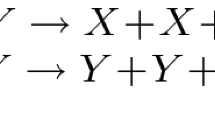Abstract
Pattern formation is a topic of great interest in biology and nanotechnology. In this paper we investigate a system of spatially-organized reactions inspired by a well-known distributed algorithm for approximate majority voting, and demonstrate that this system can lead to pattern formation from a randomly initialized starting state. We also show that the approximate majority reaction scheme can preserve an existing pattern in the face of noise, and that exerting control over reaction rates can influence the generated pattern. This work has potential applications in the rational design of pattern-forming systems in DNA nanotechnology and synthetic biology.
Access this chapter
Tax calculation will be finalised at checkout
Purchases are for personal use only
Preview
Unable to display preview. Download preview PDF.
Similar content being viewed by others
References
Turing, A.M.: The chemical basis of morphogenesis. Philosophical Transactions of the Royal Society B 237(641), 37–72 (1952)
Chirieleison, S.M., Allen, P.B., Simpson, Z.B., Ellington, A.D., Chen, X.: Pattern transformation with DNA circuits. Nature Chemistry 5, 1000–1005 (2013)
Padirac, A., Fujii, T., Estévez-Torres, A., Rondelez, Y.: Spatial waves in synthetic biochemical networks. Journal of the American Chemical Society 135(39), 14586–14592 (2013)
Angluin, D., Aspnes, J., Eisenstat, D.: A simple population protocol for fast robust approximate majority. Distributed Computing 21(2), 87–102 (2008)
Lakin, M.R., Parker, D., Cardelli, L., Kwiatkowska, M., Phillips, A.: Design and analysis of DNA strand displacement devices using probabilistic model checking. Journal of the Royal Society Interface 9(72), 1470–1485 (2012)
Lakin, M.R., Phillips, A., Stefanovic, D.: Modular verification of DNA strand displacement networks via serializability analysis. In: Soloveichik, D., Yurke, B. (eds.) DNA 2013. LNCS, vol. 8141, pp. 133–146. Springer, Heidelberg (2013)
Chen, Y.-J., Dalchau, N., Srinivas, N., Phillips, A., Cardelli, L., Soloveichik, D., Seelig, G.: Programmable chemical controllers made from DNA. Nature Nanotechnology 8, 755–762 (2013)
Cardelli, L., Csikász-Nagy, A.: The cell cycle switch computes approximate majority. Scientific Reports 2, 656 (2012)
Gillespie, D.T.: Exact stochastic simulation of coupled chemical reactions. Journal of Physical Chemistry 81(25), 2340–2361 (1977)
Doursat, R., Sayama, H., Michel, O.: A review of morphogenetic engineering. Natural Computing 12(4), 517–535 (2013)
Li, H., Carter, J.D., LaBean, T.H.: Nanofabrication by DNA self-assembly. Materials Today 12(5), 24–32 (2009)
Cross, M.C., Hohenberg, P.C.: Pattern formation outside of equilibrium. Reviews of Modern Physics 65(3), 851–1112 (1993)
Ising, E.: Beitrag zur Theorie des Ferromagnetismus. Zeitschrift für Physik 31(1), 253–258 (1925)
Antal, T., Droz, M., Magnin, J., Pekalski, A., Rácz, Z.: Formation of Liesegang patterns: Simulations using a kinetic Ising model. Journal of Chemical Physics 114(8), 3770–3775 (2001)
Murray, J.D.: A pre-pattern formation mechanism for animal coat markings. Journal of Theoretical Biology 88, 161–199 (1981)
Castets, V., Dulos, E., Boissonade, J., De Kepper, P.: Experimental evidence of a sustained standing Turing-type nonequilibrium chemical pattern. Physical Review Letters 64, 2953–2956 (1990)
Lotka, A.J.: Undamped oscillations derived from the law of mass action. Journal of the American Chemical Society 42, 1595–1599 (1920)
Volterra, V.: Fluctuations in the abundance of a species considered mathematically. Nature 118, 558–560 (1926)
Degn, H.: Oscillating chemical reactions in homogeneous phase. Journal of Chemical Education 49, 302–307 (1972)
Winfree, A.T.: Spiral waves of chemical activity. Science 175, 634–635 (1972)
Field, R.J., Noyes, R.M.: Explanation of spatial band propagation in the Belousov reaction. Nature (London) 237, 390–392 (1972)
Winfree, A.T.: Varieties of spiral wave behaviour: an experimentalist’s approach to the theory of excitable media. Chaos 1, 303–334 (1991)
Zhao, Z., Liu, Y., Yan, H.: Organizing DNA origami tiles into larger structures using preformed scaffold frames. Nano Letters 11, 2997–3002 (2011)
Frezza, B.M., Cockroft, S.L., Ghadiri, M.R.: Modular multi-level circuits from immobilized DNA-based logic gates. Journal of the American Chemical Society 129, 14875–14879 (2007)
Yashin, R., Rudchenko, S., Stojanovic, M.: Networking particles over distance using oligonucleotide-based devices. Journal of the American Chemical Society 129, 15581–15584 (2007)
Zhang, D.Y., Seelig, G.: Dynamic DNA nanotechnology using strand-displacement reactions. Nature Chemistry 3(2), 103–113 (2011)
Weitz, M., Mückl, A., Kapsner, K., Berg, R., Meyer, A., Simmel, F.C.: Communication and computation by bacteria compartmentalized within microemulsion droplets. Journal of the American Chemical Society 136(1), 72–75 (2014)
Silva-Rocha, R., de Lorenzo, V.: Engineering multicellular logic in bacteria with metabolic wires. ACS Synthetic Biology 3(4), 204–209 (2014)
Bacchus, W., Lang, M., El-Baba, M.D., Weber, W., Stelling, J., Fussenegger, M.: Synthetic two-way communication between mammalian cells. Nature Biotechnology 30(10), 991–998 (2012)
Danino, T., Mondragón-Palomino, O., Tsimring, L., Hasty, J.: A synchronized quorum of genetic clocks. Nature 463, 326–330 (2010)
Rudge, T.J., Steiner, P.J., Phillips, A., Haseloff, J.: Computational modeling of synthetic microbial biofilms. ACS Synthetic Biology 1, 345–352 (2012)
Dalchau, N., Smith, M.J., Martin, S., Brown, J.R., Emmott, S., Phillips, A.: Towards the rational design of synthetic cells with prescribed population dynamics. Journal of the Royal Society Interface 9(76), 2883–2898 (2012)
Author information
Authors and Affiliations
Corresponding author
Editor information
Editors and Affiliations
Rights and permissions
Copyright information
© 2014 Springer International Publishing Switzerland
About this paper
Cite this paper
Lakin, M.R., Stefanovic, D. (2014). Pattern Formation by Spatially Organized Approximate Majority Reactions. In: Ibarra, O., Kari, L., Kopecki, S. (eds) Unconventional Computation and Natural Computation. UCNC 2014. Lecture Notes in Computer Science(), vol 8553. Springer, Cham. https://doi.org/10.1007/978-3-319-08123-6_21
Download citation
DOI: https://doi.org/10.1007/978-3-319-08123-6_21
Publisher Name: Springer, Cham
Print ISBN: 978-3-319-08122-9
Online ISBN: 978-3-319-08123-6
eBook Packages: Computer ScienceComputer Science (R0)




